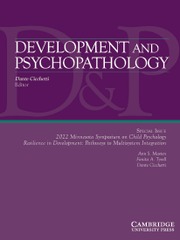Article contents
Childhood maltreatment affects adolescent sensitivity to parenting and close friendships in predicting growth in externalizing behavior
Published online by Cambridge University Press: 25 September 2018
Abstract
Childhood maltreatment robustly predicts adolescent externalizing behaviors (EB; e.g., violence, delinquency, substance use) and may crystalize patterns of EB by influencing sensitivity to the social environment (e.g., parenting, friendships). In a nationally representative sample of 9,421 adolescents, we modeled latent growth curves of EB from age 13 to 32 years. Next, we explored whether maltreated youth differed from nonmaltreated youth in their sensitivity to parental closeness, friendship involvement, and polymorphisms from dopamine genes linked to EB (dopamine receptors D2 and D4, dopamine transporter). Overall, maltreated youth had significantly higher levels of EB across adolescence and adulthood; however, maltreated and nonmaltreated youth showed similar patterns of EB change over time: violent behavior decreased in adolescence before stabilizing in adulthood, whereas nonviolent delinquency and substance use increased in adolescence before decreasing in the transition to adulthood. Maltreatment reduced sensitivity to parental closeness and friendship involvement, although patterns varied based on type of EB outcome. Finally, none of the environmental effects on EB were significantly moderated by the dopamine polygenic risk score after accounting for multiple testing. These findings underline the enduring effects of early maltreatment and implicate that maltreatment may contribute to long-term risk for EB by influencing children's sensitivity to social relationship factors in adolescence.
Keywords
Information
- Type
- Regular Articles
- Information
- Copyright
- Copyright © Cambridge University Press 2018
References
- 10
- Cited by

